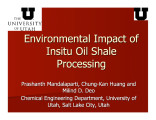TO
Filters: Collection: "ir_eua" Subject: "oil shale"
| Title | Date | Subject | Description | ||
|---|---|---|---|---|---|
| 1 |
 |
2011 Unconventional Fuels Conference - Welcome/opening remarks | 2011-05-17 | unconventional fuels; opening remarks; coal; oil shale; power generation; transportational fuel infrastructures; carbon capture; agenda | Presentation given at the 2011 University of Utah Unconventional Fuels Conference. |
| 2 |
 |
3-D structure of a local minimum of the Siskin model of oil shale kerogen using the RHF/STO-3G method | 2008 | Siskin model; oil shale kerogen; RHF/STO-3G method; kerogen; 3-D structure of kerogen; oil shale | Kerogen is a mixture of organic chemical compounds that make up a portion of the organic matter in sedimentary rocks. It is insoluble in normal organic solvents because of the huge molecular weight (upwards several thousand Daltons). When heated in the Earth's crust, (oil window ca. 6 ∞-120∞C; g... |
| 3 |
 |
Clean and Secure Energy from Domestic Oil Shale and Oil Sands Resources: Quarterly progress report - January 2015 to March 2015 | 2015 | quarterly report; domestic oil shale resources; domestic oil sands resources; unconventional fuels; oil shale; oil sands | The Clean and Secure Energy from Domestic Oil Shale and Oil Sands Resources program, part of the research agenda of the Institute for Clean and Secure Energy (ICSE) at the University of Utah, is focused on engineering, scientific, and legal research surrounding the development of these resources in ... |
| 4 |
 |
Compositional and kinetic analysis of oil shale pyrolysis using TGA-MS | 2012-04 | compositional analysis; kinetic analysis; oil shale pyrolysis; TGA-MS; oil shale; western United States; oil production | There are vast resources of oil shale in the western United States. Development of technically and economically effective technologies for the conversion of oil shale to liquid fuels will help provide a long-term and secure source of transportation fuels. Developing good understanding of the decompo... |
| 5 |
 |
Constraints on the commercialization of oil shale | 1978 | oil shale; commercialization of oil shale; constraints of commercialization; economic problems; institutional problems; surface oil shale technologies | Beyond supporting reseearch, development, and demonstration projects, government energy policy is directed toward introducing new energy technologies into commercial use. Considerable policy attention has been focused on the commercialization of energy process plants that produce substitutes for imp... |
| 6 |
 |
Depositional environments of oil shale in the Green River Formation, Douglas Creek Arch, Colorado and Utah | 1985 | depositional environments; oil shale; Green River Formation; Douglas Creek Arch; stratigraphy | Douglas Creek arch in western Colorado and eastern Utah separates the Uinta and Piceance Creek basins. During deposition of the lower part of the Eocene Green River Formation, the arch provided a physical barrier dividing ancient Lake Uinta into two segments. As the lake expanded, the arch became a ... |
| 7 |
 |
Development of CFD-based simulation tools for in situ thermal processing of oil shale/sands | 2012-02 | CFD; in situ; in situ thermal processing; oil shale; oil sands | In our research, we are taking the novel approach of developing and applying high performance computing, computational fluid dynamics (CFD)-based simulation tools to a modified in-situ process for production of oil from oil shale. The simulation tools being developed capture the relevant physical pr... |
| 8 |
 |
Development of HPC-based simulations tool for in situ thermal processing of oil shale/sands | HPC-based simulations tool; in situ thermal processing; oil shale; oil sands; commercial production of oil shale; ecoshale in-capsule process | A presentation given at the Unconventional Fuels from Oil Shale and Oil Sands Project Review Meeting on March 10-11, 2011. | |
| 9 |
 |
Dimensions, exterior surfaces, volumes, densities and shape factors for particles of crushed Colorado oil shale in two narrow sieve fractions (Abstract) | 1981-09-29 | Colorado oil shale; oil shale; narrow sieve fractions; large-scale oil extraction; factors of oil-shale particles; oil shale particles | Large-scale extraction of oil from Colorado oil shale will require that the rock be fragmented for heat processing, whether the retorting be done above or below ground level. Understanding of fluid friction, heat transfer and mass transfer in beds of shale particles requires that we be able to char... |
| 10 |
 |
The disposition of sulfur during the oxidation and subsequent leaching of retorted oil shale | 1982-03 | sulfur; oxidation of oil shale; leaching of retorted oil shale; retorted oil shale; oil shale; char | The char and iron sulfides in retorted oil shale were oxidized at temperatures from 350 to 800°C. At temperatures above approximately 550°C, sulfur was retained by the shale as water-soluble sulfates, whereas oxidation at temperatures between 400 and 500°C resulted in a loss of as much as 22% of ... |
| 11 |
 |
DOE project review: Subtask 4.2 (B): Examination of in situ production models | 2011-03-11 | DOE project review; in situ production models; oil shale; unconventional fuels; oil sands; geomechanics; general reservoir simulation tool | A presentation given at the Unconventional Fuels from Oil Shale and Oil Sands Project Review Meeting on March 10-11, 2011. The objectives of the presentation is the examination of in-situ production methods, different in-situ production method options, rigorous energy and carbon balances, exploratio... |
| 12 |
 |
Enthalpy relations for Eastern oil shale | 1987-11 | Enthalpy relations; eastern oil shale; oil shale; oil shale process; oil shale modeling; oil shale engineering; shale enthalpy | Relations were developed that allow easy and accurate calculation of enthalpy changes during the heating, retorting, or cooling of raw, spent, or burned Eastern oil shales. The heat capacities of the mineral matter, bound water, kerogen, and char, and the heat of mineral dehydration are given by lin... |
| 13 |
 |
Environmental impact of in-situ oil shale processing | 2007-10 | in situ processing of oil shale; in situ processing; oil shale; production of oil from kerogen; oil production | The in situ processing of oil shale for the production of oil from the kerogen involves heating the shale slowly to moderate temperatures of between 3000 C and 4000 C. At this temperature, gaseous products that evolve from the oil shale are condensed and recovered. The pathways of creation of oil fr... |
| 14 |
 |
Environmental technologies applicable to shale development: Integrating simulation and experiment | 2008-11-13 | oil shale technologies; oil shale; environmental technologies; shale development | Presentation given at the Utah Oil Shale Resources and Technology Update, November 13, 2008, The Leonardo, Salt Lake City, Utah. |
| 15 |
 |
Evaluating opportunities for reducing life-cycle, well-to pump GHG emissions from conventional and unconventional fuels | 2010-04-28 | unconventional fuels; GHG emissions; conventional fuels; reducing life-cycle; oil shale; oil sands; coal | Resource extraction and upgrading. |
| 16 |
 |
Evaluation of different in-situ recovery strategies | 2006-10 | in-situ recovery strategies; in-situ recovery; oil shale; thermal simulator; oil shale reservoirs; in-situ combustion; in-situ pyrolysis; modified in-situ process | Analysis of different in-situ production strategies from oil shale using a general purpose thermal simulator. |
| 17 |
 |
Evaluation of well spacing and arrangement for in-situ thermal treatment of oil shale using HPC simulation tools | 2014-10 | well spacing; in-situ thermal treatment; oil shale; HPC simulation tools; oil shale resources; oil sands resources; basin scale simulation; liquid fuel production | The mission of this presentation is to pursue research that improves industry's ability to utilize the vast energy stored in oil shale and oil sands resources with minimal environmental impact. Three main research areas looked at are: 1. Basin scale simulation of environmental and economic impacts o... |
| 18 |
 |
Extraction of hydrocarbons from Antrim oil shale | 1978 | hydrocarbon extraction; Antrim oil shale; oil shale; hydrocarbon recovery | The Dow Chemical Company has performed a variety of in situ experiments on the Antrim oil shale which underlies Michigan. These experiments have ranged from in situ combustion in a quarry to attempted extraction at a depth of 2,600 feet (780 m). Currently, Dow is continuing its efforts to obtain hyd... |
| 19 |
 |
Federal oil shale development: Status of Bureau of Land Management oil shale activities | 2011-05-17 | oil shale development; oil shale; land management; Bureau of Land Management; domestic oil shale | |
| 20 |
 |
Final report--volume 2: Publications and presentations | 1986-12 | Cooperative Agreement DE-FC21-83FE60177; Western Research Institute (WRI); DOE programs; oil shale; tar sand; underground coal gasification; advance process technology (APT); asphalt; annual and quarterly reports | Volume 2 of the final report for Cooperative Agreement DE-FC21-83FE60177 lists the publications and presentations by Western Research Institute (WRI) researchers under that agreement. Entries in this list represent the four major U.S. Department of Energy (DOE) programs included in that agreement ... |
| 21 |
 |
Fire and explosion hazards of oil shale | 1989 | fire and explosion hazards; oil shale; oil shale dust clouds; oil shale dust layers; oil shale rubble piles. | This U.S. Bureau of Mines publication presents the results of investigations into the fire and explosion hazards of oil shale rocks and dust. Three areas have been examined: the explosibility and ignitability of oil shale dust clouds, the fire hazards of oil shale dust layers on hot surfaces, and th... |
| 22 |
 |
First results and simulation of AMSO's RD&D process tests | 2012-05-15 | AMSO; RD&D; unconventional fuels; oil shale; illitic oil shale | |
| 23 |
 |
Flow of crushed oil shale through circular orifices | 1983-07-18 | crushed oil shale; oil shale; flow of oil shale; shale-oil recovery. | The gravity flow of crushed Colorado oil shale from a 7-in-diameter glass column through flat circular and converging conical orifices was studied using hign-speed cinematography. Factors tested were: (1) diameter of flat-entry and conical orifices, (2) three sizes of shale in one broad and two narr... |
| 24 |
 |
Fluidized-bed pyrolysis of oil shale | 1981-10 | Fluidized-bed pyrolysis; oil shale; isothermal fluidized-bed reactors; hydrocarbon evolution | Several quartz isothermal fluidized-bed reactors have been constructed in order to measure kinetics and oil properties relevant to surface retorting by fluidized-bed processes. The rate of volatile total hydrocarbon evolution is measured with a flame ionization detector, although various techniques ... |
| 25 |
 |
Fluidized-bed pyrolysis of oil shale: Oil yield, composition and kinetics | 1982-09 | fluidized-bed pyrolysis of oil shale; oil shale; oil yeild; oil composition; oil kinetics | A quartz isothermal fluidized-bed reactor has been used to measure kinetics and oil properties relevant to surface processing of oil shale. The rate of oil formation has been described with two sequential firstorder rate equations characterized by two rate constants. These rate constants together wi... |
